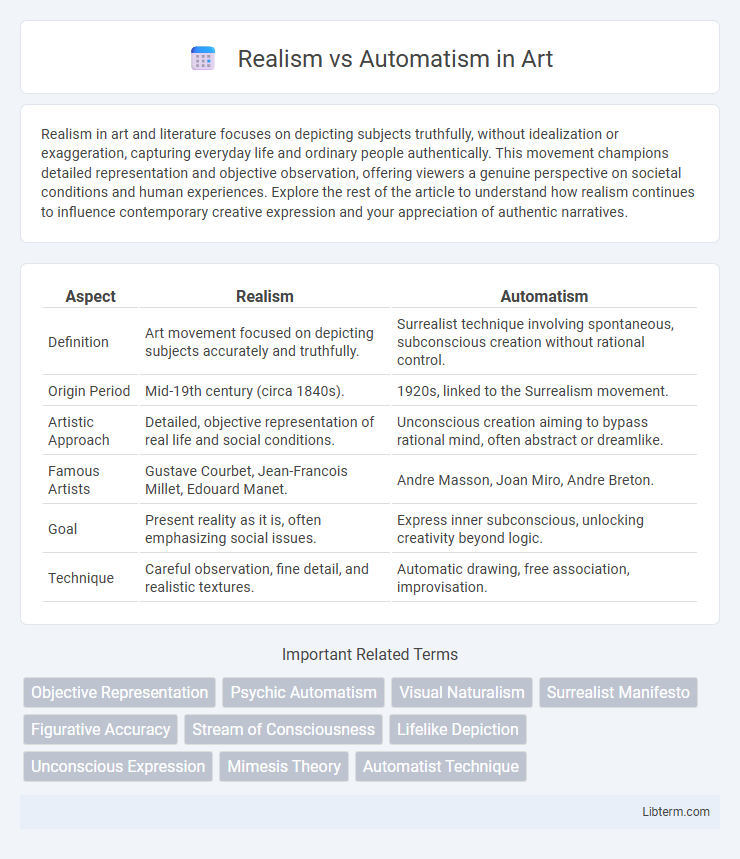Realism in art and literature focuses on depicting subjects truthfully, without idealization or exaggeration, capturing everyday life and ordinary people authentically. This movement champions detailed representation and objective observation, offering viewers a genuine perspective on societal conditions and human experiences. Explore the rest of the article to understand how realism continues to influence contemporary creative expression and your appreciation of authentic narratives.
Table of Comparison
| Aspect | Realism | Automatism |
|---|---|---|
| Definition | Art movement focused on depicting subjects accurately and truthfully. | Surrealist technique involving spontaneous, subconscious creation without rational control. |
| Origin Period | Mid-19th century (circa 1840s). | 1920s, linked to the Surrealism movement. |
| Artistic Approach | Detailed, objective representation of real life and social conditions. | Unconscious creation aiming to bypass rational mind, often abstract or dreamlike. |
| Famous Artists | Gustave Courbet, Jean-Francois Millet, Edouard Manet. | Andre Masson, Joan Miro, Andre Breton. |
| Goal | Present reality as it is, often emphasizing social issues. | Express inner subconscious, unlocking creativity beyond logic. |
| Technique | Careful observation, fine detail, and realistic textures. | Automatic drawing, free association, improvisation. |
Introduction to Realism and Automatism
Realism in art emphasizes accurate, detailed, and unembellished depiction of nature or contemporary life, rejecting idealization and focusing on everyday subjects. Automatism, often associated with Surrealism, involves creating art without conscious thought, allowing the subconscious mind to guide brushstrokes or marks to capture spontaneous expression. These contrasting approaches highlight the tension between deliberate representation and instinctive creation in artistic practices.
Defining Realism in Art and Literature
Realism in art and literature emphasizes the accurate, detailed, and unembellished depiction of everyday life, focusing on ordinary characters and settings without romanticization or idealization. This movement originated in the mid-19th century, particularly through works by Gustave Flaubert and Gustave Courbet, aiming to represent reality as it is, grounded in observable facts and social conditions. Realism seeks to portray the complexities of life through a truthful narrative that challenges subjective interpretations and fantastical elements commonly found in other styles.
Exploring Automatism: Origins and Concepts
Automatism, originating from Surrealist practices in the early 20th century, emphasizes spontaneous, unconscious creation without rational control, contrasting sharply with Realism's aim to depict life accurately. Rooted in psychoanalytic theories of the unconscious, automatism seeks to unlock creativity by bypassing deliberate intention, fostering raw, intuitive artistic expression. Key figures like Andre Breton and written or visual automatism highlight the movement's commitment to exploring the subconscious mind as a source of authentic art.
Key Differences Between Realism and Automatism
Realism emphasizes accurate, detailed representation of subjects based on observable reality, while Automatism relies on spontaneous, unconscious creation without rational control. Realism prioritizes precision and objective portrayal, whereas Automatism focuses on free expression and tapping into the subconscious mind. These fundamental differences highlight the contrasting aims of deliberate depiction versus impulsive intuition in art.
Historical Evolution of Realism and Automatism
Realism emerged in the mid-19th century as an art movement focused on representing everyday life and society with accurate, detailed depictions, reacting against Romanticism's idealism. Automatism originated in the early 20th century within Surrealism, emphasizing spontaneous, unconscious creation to bypass rational thought and explore the subconscious mind. The historical evolution of Realism traces a commitment to objective observation, while Automatism marks a radical shift toward psychological exploration and creative freedom.
Influential Figures in Realism and Automatism
Gustave Courbet and Jean-Francois Millet stand as pivotal figures in Realism, emphasizing everyday life and social issues through detailed, unidealized portrayals. Andre Breton spearheaded Automatism, encouraging spontaneous, subconscious expression as the core of Surrealism, influencing artists like Joan Miro and Max Ernst. These contrasting movements shaped modern art, with Realism grounding in tangible reality and Automatism exploring the depths of the unconscious mind.
Techniques and Methods: Realism vs Automatism
Realism emphasizes precise observation and detailed representation of subjects using techniques like controlled brushwork, accurate proportions, and natural lighting to capture reality faithfully. Automatism relies on spontaneous, unconscious creation through methods such as free association, automatic drawing, or writing, where artists bypass rational control to access the subconscious mind. These contrasting approaches highlight realism's structured, deliberate process versus automatism's fluid, intuitive expression.
Impact on Modern Art and Literary Movements
Realism emphasized accurate, detailed depictions of everyday life, shaping early modern art and influencing literary movements by promoting objective narratives and social commentary. Automatism, rooted in Surrealism, revolutionized creativity by tapping into the subconscious through spontaneous, unfiltered expression, significantly impacting modern art's abstract and experimental directions. These contrasting approaches collectively expanded artistic boundaries, fostering diverse explorations in visual arts and stream-of-consciousness literature.
Critiques and Debates: Realism vs Automatism
Critiques of Realism argue it often limits artistic creativity by adhering strictly to accurate representation and neglecting subconscious expression, while Automatism is debated for its challenge in defining artistic intention due to its reliance on spontaneous creation. Scholars highlight that Realism prioritizes external truth and objective detail, whereas Automatism seeks to access inner thoughts and emotions through unfiltered artistic processes, creating tension in evaluating art's purpose and value. Debates focus on whether true creativity emerges from conscious control in Realism or from the subconscious freedom championed by Automatism, questioning the boundaries between deliberate art and subconscious output.
Conclusion: Relevance in Contemporary Creative Fields
Realism and automatism remain influential in contemporary creative fields, shaping artistic expression and innovation. Realism continues to provide a foundation for capturing authentic experiences and social realities, while automatism inspires spontaneous creativity and subconscious exploration. The interplay between these approaches enriches multidisciplinary practices, enhancing depth and originality across visual arts, literature, and digital media.
Realism Infographic

 libterm.com
libterm.com